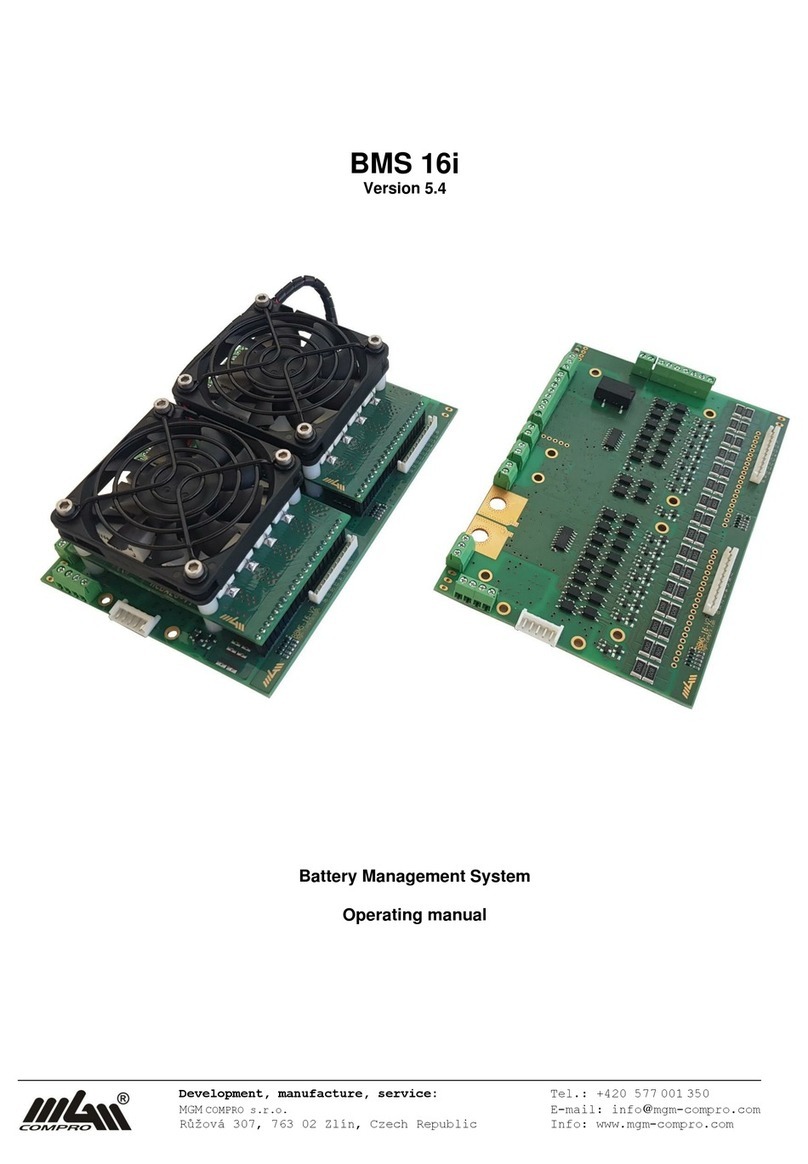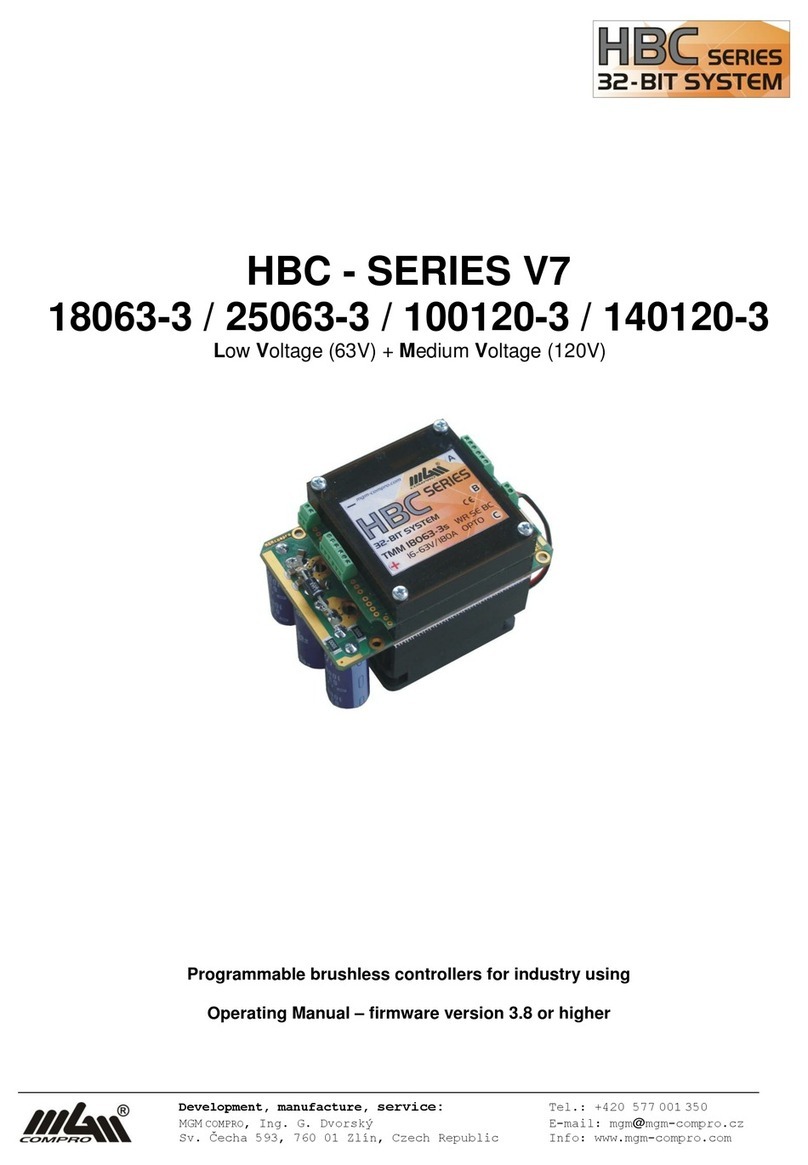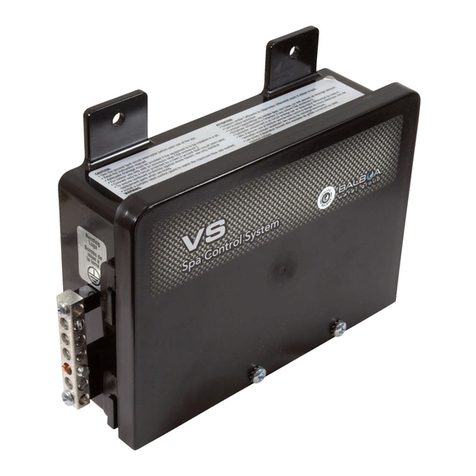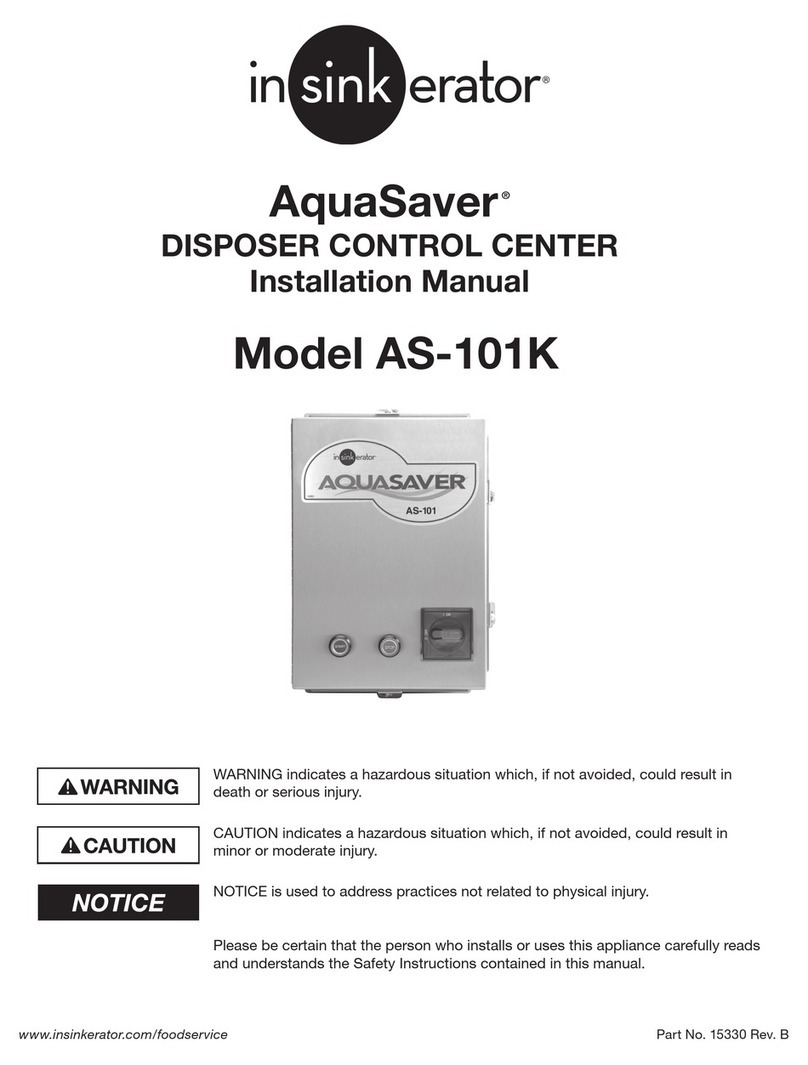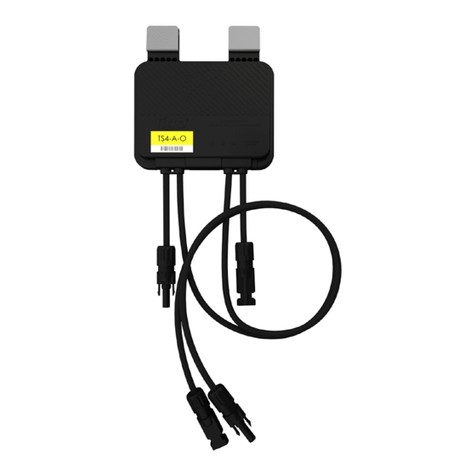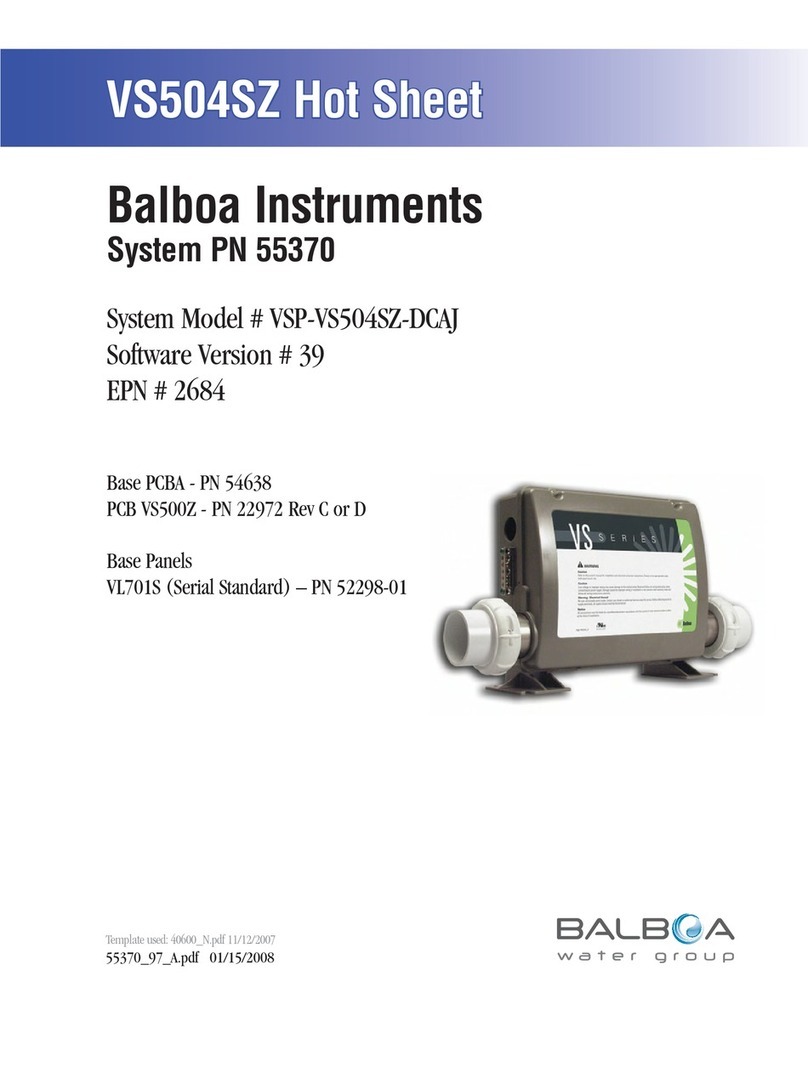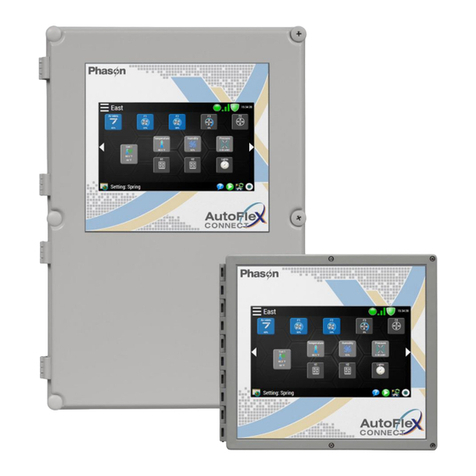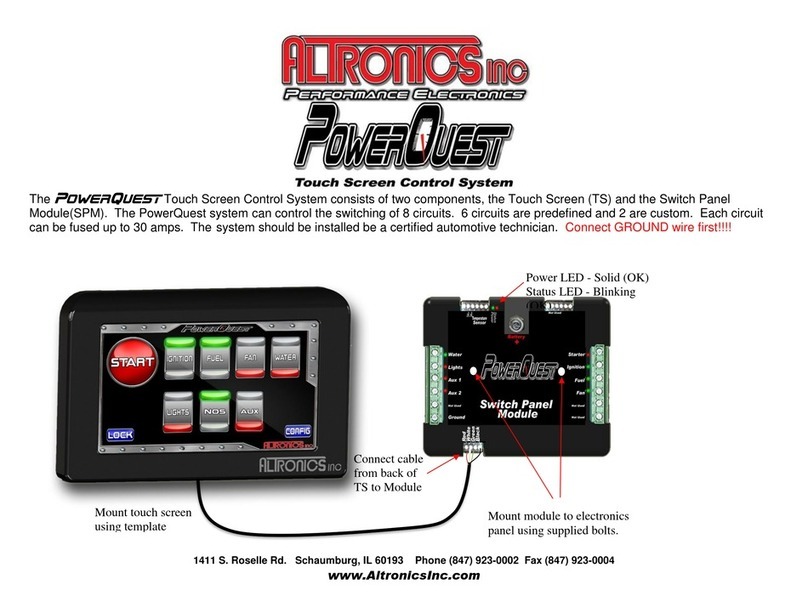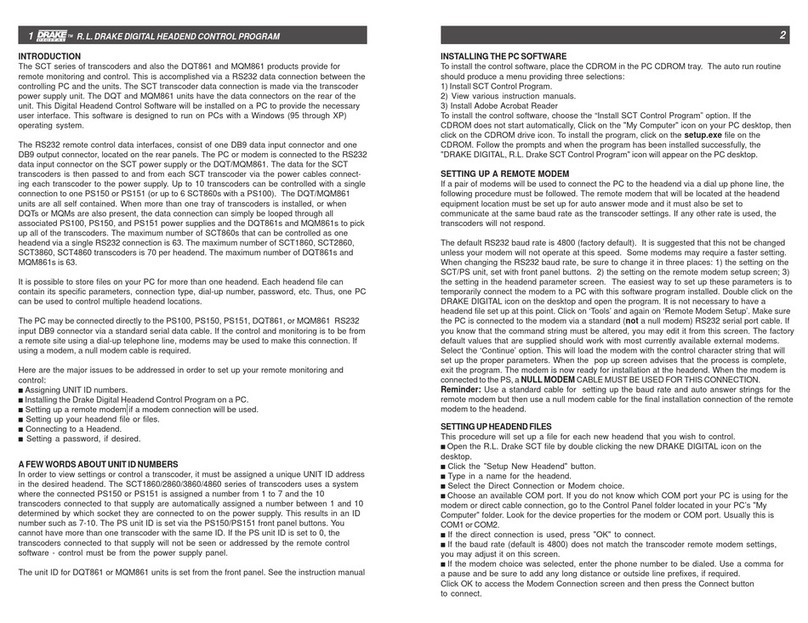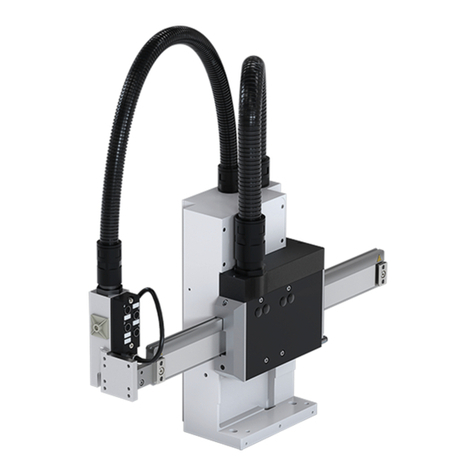MGM BMO Series User guide

Pag. 1 a 21 A20H0019
SERIE BMO
Uso e manutenzione
I T A L I A N O
Vi ringraziamo per la fiducia accordataci acquistando questo prodotto. Prima di mettere in funzione il
motore Vi raccomandiamo di leggere attentamente queste istruzioni che sono parte integrante del
prodotto e devono essere conservate insieme ad esso. Per qualsiasi difficoltà Vi preghiamo di
contattare l'organizzazione della M.G.M. specificando tipo di prodotto e numero di matricola.
Campo di applicazione
Queste istruzioni sono valide per tutti i motori appartenenti alla serie BMO (BMO, BMXO, BMOE,
BMXOE, BMOEAV, BMXOEAV, BMOAV, BMXOAV, BMOMP, BMOSV, BMXOSV, BMOESV,
BMXOESV). Per motori con esecuzioni speciali attenersi alle indicazioni contenute nelle istruzioni
aggiuntive che devono essere conservate insieme al presente manuale.
Maggiori informazioni sono disponibili sul nostro sito web (www.mgmrestop.com). La serie BMO è
costituita da motori elettrici autofrenanti asincroni trifase o monofase con costruzione chiusa e
ventilazione esterna. Il freno interviene solo quando alimentato elettricamente.
I motori della serie BMO sono destinati ad essere utilizzati come componenti in applicazioni
industriali. Le prestazioni e le caratteristiche riportate sulla targa del motore sono garantite per
installazioni in ambienti con temperatura compresa tra -15° C a + 40° C e altitudine inferiore a 1000
metri s.l.m.
Informazioni generali sulla sicurezza
Durante il funzionamento i motori presentano parti sotto tensione o in movimento. La
rimozione delle necessarie protezioni elettriche e meccaniche, l'uso improprio o la non
adeguata manutenzione possono causare gravi danni a persone e cose.
Le operazioni di installazione, manutenzione, regolazione, sostituzione di componenti
devono essere fatte da personale qualificato utilizzando strumenti di lavoro adeguati,
avendo preventivamente verificato che il motore o l'impianto sia scollegato dalla rete di
alimentazione e che sui terminali in morsettiera non sia presente tensione residua.
È necessario evitare il contatto con la superficie del motore dal momento che durante il
funzionamento la temperatura può superare i 50° C.
Ricevimento e magazzinaggio
All'atto del ricevimento verificare che le caratteristiche riportate sulla targa del motore coincidano con
quanto richiesto e che il motore non abbia subito danni durante il trasporto; eventuali danni
dovranno essere immediatamente segnalati al trasportatore.
I golfari se presenti servono al sollevamento del solo motore e non di altre macchine ad
esso accoppiate.
Immagazzinare i motori in luogo asciutto e privo di polvere.

Pag. 2 a 21 A20H0019
Installazione
All'atto dell'installazione verificare che le caratteristiche richieste del motore coincidano
con quanto riportato sulla targa con particolare attenzione alla tensione di alimentazione
e alla coppia frenante massima.
Verificare che la coppia frenante fornita dal gruppo freno sia adeguata per l'applicazione
prevista. Verificare che il tipo di freno installato sul motore sia idoneo per l'applicazione
prevista e che sia conforme a eventuali norme e prescrizioni vigenti.
La serie BMO non comprende motori idonei ad essere utilizzati in ambienti con pericolo
di esplosione. L'uso di un motore non idoneo in un ambiente con pericolo di esplosione
può causare gravi danni a persone e cose.
Verificare che il grado di protezione IP indicato in targa sia idoneo per l'applicazione
prevista.
Verificare che le guarnizioni siano in perfette condizioni e perfettamente alloggiate nelle
loro sedi, che le aperture di ingresso cavo siano ben chiuse, che le viti della scatola
morsettiera siano serrate in modo che sia garantito il grado di protezione indicato in
targa.
Per installazioni all'aperto si raccomanda di proteggere opportunamente il motore dalle
intemperie. E' opportuno inoltre evitare di installare il motore con i bocchettoni
d'ingresso dei cavi posizionati verso l'alto. Si consiglia inoltre che i cavi arrivino dal basso
verso l'alto per evitare fenomeni di gocciolamento o ristagno dell' acqua Per motori con
montaggio in posizione verticale è necessario che il motore sia provvisto di tettuccio
parapioggia. Nel caso in cui siano rimossi i golfari, se presenti, è necessario per garantire
il grado di protezione IP, che siano sostituiti con viti di medesimo passo e lunghezza.
Il motore deve essere installato in un locale areato lontano da fonti di calore e in
posizione tale da consentire libera aspirazione dell'aria per una corretta ventilazione. Il
motore deve essere collocato in modo da consentire agevoli operazioni di ispezione e
manutenzione tenendo conto di eventuali pericoli derivanti dal contatto con parti in
movimento.
Verificare prima della messa in servizio o dopo lunghi periodi di inattività o giacenza in
magazzino che la resistenza di isolamento verso massa non sia inferiore a 75 MΩ (la
misura deve essere fatta con strumento Megger 500 V DC). Non toccare i morsetti
durante e negli istanti successivi alla misurazione in quanto i morsetti sono sotto
tensione.
L'equilibratura dei motori è stata realizzata con mezza chiavetta applicata all'estremità d'albero
(EN60034-14).
Per l'ancoraggio del motore utilizzare viti di fissaggio di materiale adeguato e del diametro massimo
compatibile con i fori previsti sulla flangia o sui piedini. Qualora il motore sia dotato di piedini
scegliere un piano di appoggio solido e rigido in modo da rendere minime le vibrazioni durante il
funzionamento.
All'atto del montaggio assicurarsi che l'allineamento fra l'asse del motore e quello dell'albero
condotto sia tale da non provocare vibrazioni delle due parti. In particolare all'atto del
montaggio verificare, nel caso di motori con flangia, che le superfici di accoppiamento siano ben
pulite e che il centraggio non determini disallineamento dei fori di fissaggio tale da impedire
l'agevole passaggio delle viti. Per motori con piedi verificare nel caso di accoppiamento con giunti
che l'asse del motore e della macchina condotta coincidano e che, nel caso si effettui l'accoppiamento
con pulegge, la tensione delle cinghie non sia eccessiva.

Pag. 3 a 21 A20H0019
Manutenzione periodica
Le operazioni di manutenzione devono essere svolte solo da personale qualificato e solo
dopo aver scollegato l'impianto o il motore dalla rete di alimentazione (incluso eventuali
ausiliari come ad esempio le scaldiglie anticondensa) e aver verificato che nessun carico
sia applicato all'albero del motore.
Maneggiare il gruppo elettromagnete con mani pulite perché ogni traccia di grasso
diminuisce la capacità frenante e aumenta la rumorosità.
Per interventi sui motori monofase attendere che i condensatori si siano scaricati.
E' necessario evitare che possano verificarsi riavviamenti automatici che possono
determinare situazioni pericolose per persone o cose.
Per motivi di sicurezza la chiave esagonale a T non deve mai essere lasciata inserita nel
motore ma rimossa e tenuta dal responsabile della manutenzione dell'impianto dopo
ogni intervento.
La chiave esagonale a T per la rotazione manuale deve essere usata solo dopo aver
disconnesso il motore dalla rete di alimentazione e aver verificato che nessun carico è
applicato all'albero del motore.
Dopo ogni operazione di regolazione, manutenzione o sostituzione di componenti
verificare che il gruppo freno eroghi la coppia frenante richiesta.
Le operazioni che devono essere effettuate periodicamente allo scopo di assicurare il corretto
funzionamento del motore autofrenante MGM sono elencate di seguito. La frequenza delle ispezioni
dipende dalla particolare applicazione del motore ( numero di avviamenti, momento di inerzia
applicato, condizioni ambientali, etc.).
In generale si raccomanda di procedere alla prima ispezione dopo poche settimane di funzionamento
e di stabilire conseguentemente un programma di manutenzione periodica. Si raccomanda
comunque di effettuare le ispezioni successive alla prima con una frequenza di almeno due volte
all'anno. Per maggiori informazioni Vi preghiamo di contattare l'organizzazione della M.G.M. motori
elettrici S.p.A.
- Verificare il saldo ancoraggio del motore attraverso la flangia o i piedini.
- Verificare che l'assorbimento di corrente non superi il valore riportato in targa.
- Verificare che le aperture per il passaggio dell'aria per la ventilazione non siano ostruite.
- Verificare il corretto serraggio dei cavi di alimentazione e del conduttore di terra.
- Verificare che il traferro non superi i valori indicati nella tabella 1. Si consideri che l'usura
delle superfici frenanti è maggiore durante la fase di rodaggio (alcune migliaia di frenate). Per
la regolazione del traferro seguire le indicazioni contenute nel paragrafo 'Regolazione del
traferro'.
- Verificare lo stato di usura della superficie di attrito, assicurandosi che a causa di un consumo
eccessivo del ferodo, il contatto tra ancora mobile BMO (136) e gruppo elettromagnete (134)
non avvenga tra due superfici metalliche. In tal caso, si raccomanda di procedere con la
sostituzione del gruppo elettromagnete (vedere relativo paragrafo). Il ferodo è parte
integrante del gruppo elettromagnete (134).
- I componenti del gruppo freno sono soggetti ad usura, è pertanto necessario, per motivi di
sicurezza, provvedere alla loro sostituzione periodica come manutenzione preventiva. La

Pag. 4 a 21 A20H0019
frequenza dipende dal lavoro svolto dal motore ( numero di avviamenti/arresti, momento
d'inerzia applicato, condizioni ambientali etc.). Si raccomanda comunque di provvedere alla
loro sostituzione con una frequenza non superiore ai 18 mesi.
Valori traferro gruppo freno BMO
Tipo gruppo freno 65 80 100 125 160
Traferro nominale (mm) 0,2÷0,3 0,2÷0,3 0,2÷0,3 0,3÷0,4 0,3÷0,4
Traferro max (mm) 0,6 0,8 1,0 1,2 1,2
Tabella 1
Nota: Nella tabella 1 sono indicati i tipi di gruppo freno usualmente utilizzati. Per esecuzioni
speciali potrebbe essere usato un diverso tipo di gruppo freno. Per maggiori informazioni
contattare MGM
Regolazione del traferro
Il traferro esistente tra l’ancora mobile BMO (136) ed il ferodo sul gruppo elettromagnete (134),
rilevabile per mezzo di uno spessimetro, deve obbligatoriamente rimanere entro i valori massimi
indicati (vedere tabella 1), quando supera tali valori, è necessario riportare il traferro alla condizione
nominale. A tale scopo occorre agire sulla ghiera autobloccante blocca ancora (137). Per facilitare le
operazioni, all’estremità dell’albero è presente un esagono incassato o una spianatura che
consentono di bloccare l’albero con una chiave a brugola o con una chiave a forchetta. Una volta
completata l’operazione, verificare nuovamente il traferro e se necessario ripetere l’operazione.
Sostituzione del gruppo elettromagnete
Svitare le viti di ancoraggio (82) della cuffia (76) ed estrarla. Dopo aver tolto l'anello blocca ventola
(72), aver sfilato la ventola (71), svitare la ghiera autobloccante blocca ancora (137). Per facilitare le
operazioni, all’estremità dell’albero è presente un esagono incassato o una spianatura che
consentono di bloccare l’albero con una chiave a brugola o con una chiave a forchetta. Una volta
rimossa la ghiera, sfilare l’ancora mobile BMO (136), quindi svitare le viti di serraggio gruppo
elettromagnete (135). Sfilare il gruppo elettromagnete (134) e sostituire con il nuovo. Fare in modo
che il gruppo elettromagnete sia sistemato correttamente all’interno della sua sede. Per rimontare
procedere a ritroso, effettuando anche la registrazione del traferro. Maneggiare il gruppo
elettromagnete con mani pulite perché ogni traccia di grasso diminuisce la capacità frenante e
aumenta la rumorosità.

Pag. 5 a 21 A20H0019
Collegamento Elettrico
Prima di collegare il motore alla rete di alimentazione, deve essere effettuato il
collegamento verso terra mediante i morsetti posti all'interno della scatola morsettiera e
sulla carcassa del motore. Tali morsetti devono essere puliti e protetti dalla corrosione.
Per il collegamento del motore alla rete di alimentazione e per il collegamento verso terra, utilizzare
conduttori di sezione adeguata e in accordo alle norme vigenti. Si raccomanda di seguire le
indicazioni contenute nella norma EN 60204.
Per il collegamento alla rete attenersi scrupolosamente agli schemi illustrati qui di seguito. Per il
collegamento di motori singola velocità, per Usa e Canada, attenersi invece alle relative istruzioni
aggiuntive.
Dopo aver effettuato il collegamento dei motori verificare accuratamente il serraggio dei dadi dei
morsetti.
Per i motori comandati da inverter per il cablaggio attenersi alle indicazioni fornite dal costruttore di
inverter.
Per l'eventuale collegamento di dispositivi ausiliari (protezioni termiche, scaldiglie anticondensa,
ventilazione ausiliaria) si consideri l'identificazione dei cavi secondo quanto descritto nel relativo
paragrafo.
L'alimentazione dell'elettromagnete del freno avviene attraverso un raddrizzatore alloggiato
all'interno della morsettiera (eccetto che per il freno a 24V D.C.). La tensione di alimentazione del
raddrizzatore lato corrente alternata è indicata sulla targhetta del motore.
Il raddrizzatore può essere fornito indifferentemente del tipo Q o del tipo M. Attenersi per il
collegamento agli schemi Q ed M. Nei motori con freno 24VDC il raddrizzatore non è presente.
In caso di interruzione dell’alimentazione sul lato continuo, è utile proteggere i terminali da
sovratensioni con un filtro RC o con un diodo di ricircolo.
Per ogni difficoltà Vi preghiamo di contattarci.
Raddrizzatore M - Rectifier M

Pag. 6 a 21 A20H0019
Raddrizzatore Q - Rectifier Q
Identificazione dei cavi dei dispositivi ausiliari
Nella tabella sottostante sono indicati i simboli utilizzati all’interno della scatola morsettiera (vedere
foto a lato come esempio) per l’identificazione dei cavi dei dispositivi ausiliari. La tensione di
alimentazione delle eventuali scaldiglie o dei servoventilatori è indicata sulla targa del motore. Per
qualsiasi dubbio sul collegamento dei dispositivi ausiliari vi preghiamo di contattarci.
Nota: a secondo del tipo di motore e degli eventuali dispositivi ausiliari presenti, il tipo di
morsettiera e la posizione dei terminali dei dispositivi ausiliari sulla morsettiera potrebbero
essere diversi da quanto indicato nella fotografia scelta come esempio.
La scaldiglia anticondensa può essere alimentata solo dopo avere spento il motore. Non
deve essere alimentata durante il funzionamento del motore.
L’eventuale servoventilazione assicura, durante il funzionamento del motore principale, la
sottrazione del calore di dissipazione. Verificare una volta spento il motore, in base alla
temperatura raggiunta, l’eventuale necessità di prevedere il proseguimento della
ventilazione per un periodo aggiuntivo. Nelle unità di ventilazione forzata ad alimentazione
trifase il cui il funzionamento dipende dal senso di rotazione occorre rispettare il senso di
rotazione (vedi freccia indicatrice del senso di rotazione).
Dispositivo Identificazione cavi
Scaldiglie motore HT
Termoprotettori (PTO) TP
Termistori (PTC) TM
Servoventilazione SV
Scaldiglie freno HB

Pag. 7 a 21 A20H0019
BMO / BMXO
Motore trifase a singola velocità
BMOD
Motore trifase a due velocità – Dahlander

Pag. 8 a 21 A20H0019
BMODA
Motore trifase a due velocità – Due avvolgimenti
BMOMP
Motore monofase

Pag. 9 a 21 A20H0019
Raddrizzatore - Rectifier
Bassa velocità - Low speed
Alta velocità - High speed
Recupero/Smaltimento
Lo smaltimento del motore deve avvenire nel rispetto delle normative vigenti nel paese
d'installazione.
Il simbolo del cassonetto barrato, riportato sulla targa, indica che il prodotto alla fine della
propria vita utile, non deve essere smaltito come rifiuto urbano misto ma deve essere
raccolto separatamente dagli altri rifiuti ed avviato a recupero o eventuale smaltimento
secondo specifiche modalità per contribuire ad evitare possibili effetti negativi
sull'ambiente e sulla salute e per favorire il reimpiego e/o riciclo dei materiali di cui è
composto il motore.
La maggior parte dei componenti del motore è realizzata con materiali (acciaio, rame, alluminio, etc..)
che possono essere riutilizzati/riciclati contribuendo in questo modo alla tutela dell'ambiente.
Per ricevere maggiori informazioni sulle modalità di smaltimento/recupero o informazioni specifiche
sui vari materiali delle parti che costituiscono il motore visitare il nostro sito web
(www.mgmrestop.com) oppure contattare MGM Italia.

Pag. 10 a 21 A20H0019
Per eventuali richieste di ricambi, indicare il numero del pezzo, il tipo del motore e il numero di
matricola.
2 Chiavetta
3 Cuscinetti
4 Scudo lato comando (B3)
7 Carcassa motore
28 Viti coperchio morsettiera
29 Scatola morsettiera doppia
30 Morsettiera
32 Bocchettone pressacavo
36 Scudo a flangia (B5)
37 Scudo a flangia (B14)
38 Rosetta elastica
compensatrice
51 Chiave a T per rotazione
albero (a richiesta)
71 Ventola
72 Anello elastico blocca
ventola
76 Cuffia protezione freno
81 Gruppo albero rotore
82 Vite cuffia freno
83 Chiavetta gruppo freno
84 Scudo lato freno
88 Tirante
89 Pipetta passafilo scatola
morsettiera
133 Molla a tazza
134 Gruppo elettromagnete
135 Vite di fissaggio freno BMO
136 Ancora mobile BMO
137 Ghiera autobloccante blocca ancora

Pag. 11 a 21 A20H0019
SERIE BMO
Use and maintenance
ENGLISH
We would like to thank you for trusting us and buying our product. Before starting the motor, we
advise you to read these instructions carefully, which should be kept together with it.
Should any difficult arise, please contact the MGM organization, specifying the type of product and its
serial number.
Field of application
This Use and Maintenance book is valid for electric motors belonging to the BMO series (BMO,
BMXO, BMOE, BMXOE, BMOEAV, BMXOEAV, BMOAV, BMXOAV, BMOMP, BMOSV, BMXOSV,
BMOESV, BMXOESV). For special execution motors please refer to the additional instructions which
must be kept with this manual.
Further information are available on our web site (www.mgmrestop.com).
BMO series includes asynchronous three-phase or single-phase totally enclosed fan cooled brake
motors. The brake functions only when electrically supplied. BMO series-motors are used as
components in industrial applications.
Performance and characteristics shown on the motor nameplate are guaranteed for installations in
ambients having a temperature range between -15° C and +40° C at an altitude below 1000 m above
sea level.
General safety information
During operation, motors have live or moving parts. Therefore, removal of electrical or
mechanical guards, improper use, or inadequate maintenance may cause serious damage
to persons or property.
Installation, Maintenance, Adjustment, Replacement operations of components must be
carried out by qualified personnel, using proper tools and working instruments. Above
all, it is essential to verify that motor or plant are disconnected from the supply line and
that on the terminal board there is no voltage left.
Avoid contact with the motor case since the temperature under normal operating
conditions may exceed 50°C.
Receipt and Storage
When receiving the motor, it is essential to check that all the characteristics shown on the
motor nameplate correspond to the requested ones and that the motor has not been
damaged during transportation. Any damage must be pointed out to the carrier
immediately.

Pag. 12 a 21 A20H0019
The ringbolts, if any must be used to lift only the motor without any other machines fitted
to it.
The motors must be stored in a sheltered, dry and dust-free place.
Installation
When the installation is started, be sure that the characteristics expected from the motor
are in accordance with the ones shown on the motor nameplate, being careful to the
supply voltage and to the maximum braking torque.
Make sure that the braking torque supplied by the brake assembly is suitable for the
application required. Please verify that the type of brake is suitable for the application and
in compliance with standards or rules in force on the machine on which the motor will be
incorporated.
BMO series doesn't include motors suitable for hazardous environment. Misapplication of
a motor in hazardous environment can cause fire or an explosion and result in a serious
injury.
Verify that the IP protection degree stated on the nameplate is suitable for the application
required. For outdoor installations, it's recommend to protect the motor against exposure
to the sun and against bad weather conditions. Please check that the cable entry is not on
the top of the terminal box. We suggest in any case that the connection cable come from
the bottom upwards in order to avoid drip and water stagnation at cable entry. For
outdoor vertical mounting with shaft down a special rain canopy is required.
Check that all gaskets are in perfect conditions and well housed into their seats; check
that the cable inlet openings are tightly closed and that the terminal box screws are well
tightened so that the protection level shown on the plate is respected. The ringbolts if
removed must be replaced with screws with the same length and pitch to guarantee the
IP protection degree.
The motor must be installed in a ventilated room away from heat sources and in such a
position to allow free air intake for a proper ventilation. The motor must be also mounted
in such position so that easy inspection and maintenance operations are allowed,
avoiding any possible danger arising from contact with moving parts.
Before starting the motor or after long periods of inactivity or storage, check that the
earth insulation resistance is not less than 75 MΩ (the measuring must be done with a
500V DC Megger instrument). Never touch the terminals during and immediately after
measurement since they may carry dangerous voltages.
The motor is balanced with half key fitted (60034-14).
When mounting the motor, check that the fixing screws are of suitable material and have the proper
diameter to be fitted with the holes provided on flange or feet. If the motor is equipped with feet, a
rigid and solid surface is to be used, in order to have minimum vibrations during operation.
During the mounting operation, check that motor and machine coupling is accurately aligned, as an
imperfect alignment could cause vibrations. In case of motors with flange, make sure that the
coupling surfaces are thoroughly cleaned and that the centering is properly done so to allow screws
going through easily. In case of motors with feet, when using couplings with joints, check that the

Pag. 13 a 21 A20H0019
motor axis and the driven machine axis are in line. When using pulleys, check that the belt tension is
not too high.
Maintenance
Maintenance operations must be carried out by qualified personnel, and only after having
disconnected the plant or the motor from the electrical supply (including any possible
auxiliaries and especially anticondensation heaters) and after having checked that no load
is applied to the driveshaft.
Please handle the electromagnetic group with clean hands, as any trace of oil diminishes
the brake torque and increases noise.
Discharge all capacitors before servicing a single phase motor.
Prevent uncontrolled restarting of the motor as this may be extremely hazardous for the
operator and may cause serious damage.
For security reasons the hexagonal 'T' key must never be fitted on the motor but removed
and kept by the plant maintenance responsible after every intervention.
The hexagonal 'T' key must be used only after having disconnected the motor from the
electrical supply and after having checked that no load is applied to the driveshaft.
After any regulation, maintenance or replacement operations of components, please
verify that the brake delivers the required brake torque.
The operations which must be carried out periodically in order to ensure the correct functioning of
the MGM brake motor are listed further on. The frequency of inspection depends on the particular
motor duty (number of start/stop, applied moment of inertia, environment conditions and so on).
Generally, it's advisable to proceed to the first inspection after few weeks of working and to draw up a
periodical maintenance plan. Anyway, it's recommended to provide inspections at least twice a year.
For specific information please contact the M.G.M. motori elettrici S.p.A. organization.
- Periodically check that the motor properly operates without abnormal noise or vibrations
which could mean deterioration of bearings. Bearings mounted on MGM motors are of life-
lubricated double-screen waterproof type.
- Check that the motor is tightly fixed through flange and feet.
- Check that the current does not exceed the value written on the nameplate.
- Check that the air openings for ventilation are not obstructed.
- Check that the feeding cables and earth grounding are correctly tightened.
- Check that the air gap does not exceed the values shown on table 1. Please note that the brake
surfaces wear is greater during the run-in. (few thousands stops). For the air gap adjustment,
follow the instructions given into the paragraph "Air Gap Adjustment".
- Check the wear on the friction surface, making sure that the contact between BMO brake
moving element (136) and electromagnetic group (134) does not occur between metallic
surfaces. The friction surfaces is placed on the electromagnetic group (134)
- Verify periodically that the braking torque is suitable. If needed, proceed to its adjustment as
stated in the paragraph "Braking torque adjustment".
- All brake assembly components are subject to wear. In consideration of safety, it's needed to
replace them periodically as preventive action. The replacement frequency comes from the
motor duty (number of start/stop, applied moment of inertia, environment conditions and so
on), we recommend however to replace them at least every 18 months.

Pag. 14 a 21 A20H0019
BMO air gap range values
Brake assembly type 65 80 100 125 160
Nominal air gap value (mm) 0,2-0,3 0,2-0,3 0,2-0,3 0,3-0,4 0,3-0,4
Maximum air gap value (mm) 0,6 0,8 1,0 1,2 1,2
Table 1
Note: Table 1 refers to the brake groups usually used. For special execution motors, a different
association might be used. For further information, please contact MGM.
Air Gap Adjustment
The air gap between the BMO brake moving element (136) and brake friction surface on the
electromagnetic group (134) must mandatorily remain within the maximum values shown in table 1.
The air gap is measurable via a feeler gauge. In case these values are exceeded, it is necessary to
readjust the air gap to the nominal values. To do so, it is necessary to operate on the self-locking
ferrule (137). To facilitate locking operations, an in-built hexagon or a flattening are present on the
shaft, allowing to lock the shaft with an allen key or with a fork wrench. Once completed the
operation, please check again the air gap and if necessary, repeat the operations.
Electromagnetic group replacement
Unscrew the fixing screws (82) from the fan cover (76) hence remove it. After having removed the fan
snap ring (72), and the fan (71), unscrew the self-locking ferrule (137). To facilitate locking operations,
an in-built hexagon or a flattening are present on the shaft, allowing to lock the shaft with an allen key
or with a fork wrench.
Once having removed the self-locking ferrule, remove the BMO brake moving element (136) hence
unscrew the brake fixing screws (135). Remove the electromagnetic group (134) and replace with the
new one. Please ensure that the electromagnetic group is inserted correctly into the seat. For re-
assembly proceed backwards, completing also an air gap adjustment procedure. Make sure to handle
the electromagnetic group with clean hands, as any trace of oil diminishes the brake torque and
increases noise.

Pag. 15 a 21 A20H0019
Wiring
Before connecting the motor to the power supply, it is necessary to connect the earth
wire. This is accomplished by using the terminals, which are in the terminal box and on
the motor frame. These terminals must be clean and protected from corrosion.
Properly sized wires must be used, both to connect the motor to the power supply and to connect the
earth wire, and they must conform to all applicable norms and regulations. It's recommended to
follow the specifications stated in the EN 60204 standard.
To connect the power supply, the wirings instructions here below must be followed exactly. For the
wirings of those single speed motors destined to USA and Canada, please follow up the additional
instructions.
After the connection is completed, check thoroughly the tightening of the terminals nuts. About the
wiring of the motors driven by an inverter, please follow up the inverter manufacturer instructions.
For the connection of the auxiliary devices (such as thermal protectors, heaters, forced ventilation and
so on) please consider the identification of the cables described in the relevant paragraph.
For the connection of the auxiliary devices (such as thermal protectors, heaters, forced ventilation and
so on) please consider the identification of the cables Brake coil is fed through a rectifier located
inside the terminal box (except for the 24V DC brake).
The AC side rectifier supply is stated on motor name plate. Rectifiers can be equipped either with type
Q or type M. For connections, diagrams Q and M are to be followed.
In the motors supplied with a 24VDC brake the rectifier is not supplied. In case of whatever difficulty
please contact us.
When switching the electromagnetic group on DC side it is useful to protect the contacts from burn
out (RC device or free-wheeling diode)
For any query, please contact us.
Raddrizzatore M - Rectifier M

Pag. 16 a 21 A20H0019
Raddrizzatore Q - Rectifier Q
Auxiliary devices identification
The below table shows the symbols used inside the terminal board box in order to identify all of the
auxiliary devices (please refer to the picture). The supply tension of the heaters or of the forced
ventilation (if present) is indicated on the nameplate. For any doubt, please do not hesitate to contact
us
Note: depending on the motor type and on the requested auxiliary devices, the terminal
board used and the position of the auxiliary devices terminal connections might change
from what shown in the example picture.
The heater must be powered only after having turned off the motor. Do not power the heater
while the motor is running.
The presence of the forced ventilation ensures that dissipation heat is removed while the
principal motor is working. Once the motor is turned off, please verify the necessity of using
the forced ventilation for an additional period of time. In three-phase forced ventilation units,
please check the sense of rotation of the fan. The effective functioning of the three-phase fan
depends on the sense of rotation. (please refer to the sense of rotation arrow on the fan).
Device Cable identification
Motor heaters HT
Thermal protectors (PTO) TP
Thermistors (PTC) TM
Forced ventilation SV
Brake coil heaters HB

Pag. 17 a 21 A20H0019
BMO / BMXO
Three phase single speed motor
BMOD
Three phase double speed motor – Dahlander

Pag. 18 a 21 A20H0019
BMODA
Three phase double speed motor – Double windings
BMOMP
Single phase motor

Pag. 19 a 21 A20H0019
Raddrizzatore - Rectifier
Bassa velocità - Low speed
Alta velocità - High speed
Recovery/disposal
Disposal of the motor must be carried out in compliance with current applicable regulations in the
country of installation.
The crossed-out waste bin symbol, contained on the information plate, indicates that, at
the end of its useful life, the product must not be disposed of as urban waste but must be
collected separately from other waste and sent for recovery or possible disposal according
to specific methods for avoiding possible negative effects on the environment and to
health, and for favoring its re-use and/or recycling of the materials of which it is made up.
The greater part of the motor components is made up of materials (steel, copper, aluminium, etc,)
which could be re-used/recycled, thus contributing towards safeguarding the environment.
For further information on modes of disposal/recovery or specific information on the various
materials making up the motor, visit our website (www.mgmrestop.com) or contact MGM Italia.

Pag. 20 a 21 A20H0019
For all spare part requirements, please indicate number of item, motor type and serial number.
2 Key
3 Bearing Drive End Side
4 Endshield Drive End (B3)
7 Stator Frame
28 Terminal Box Screws
29 Double terminal box
30 Terminal Box
32 Cable Gland
36 Flange B5
37 Flange B14
38 Elastic washer
51 Allen key for manual shaft rotation (on
request only)
71 Fan
72 Fan Snap Ring
76 Fan Cover
81 Complete rotor
82 Fan Cover Screw
83 Brake assembly key
84 Endshield Brake Side (rear cover)
88 Tie Rod
89 Rubber sleeve
133 Disc Spring
134 Electromagnetic Group
135 BMO Fixing Screw
136 BMO Brake Moving Element
137 Self-locking Ferrule
This manual suits for next models
13
Table of contents
Languages:
Other MGM Control System manuals
Popular Control System manuals by other brands
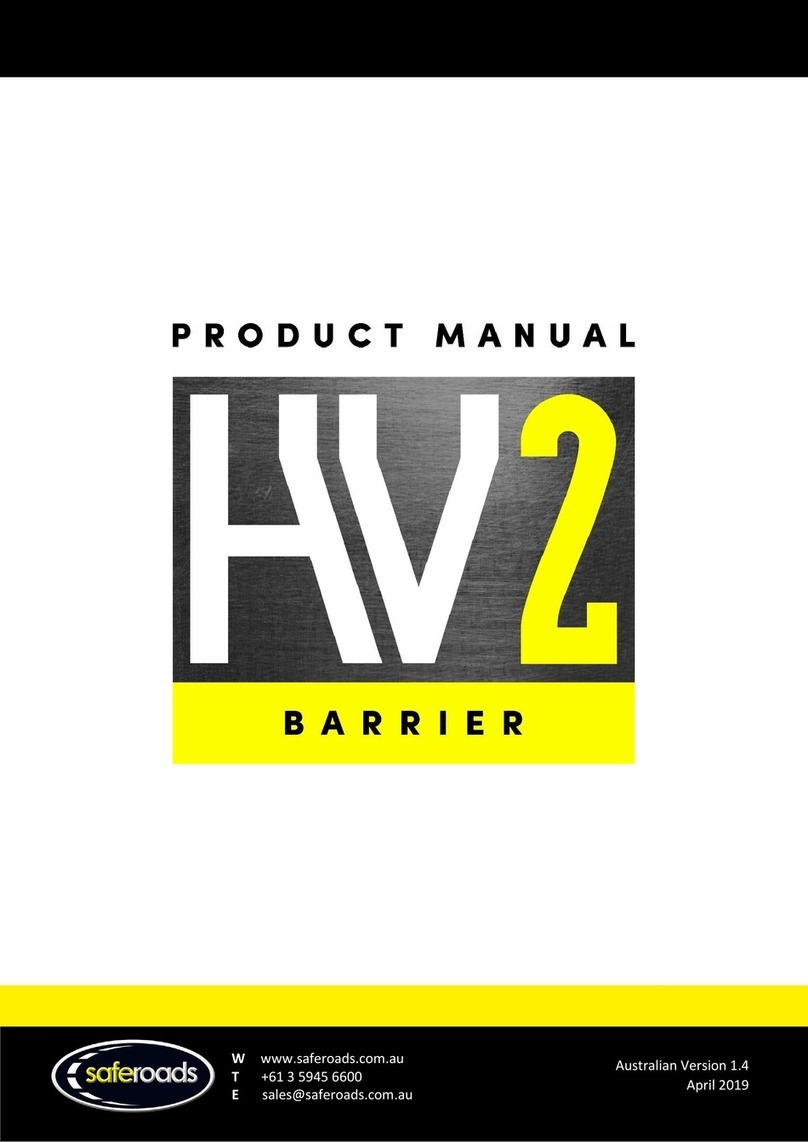
Saferoads
Saferoads HV2 Safety Barrier product manual
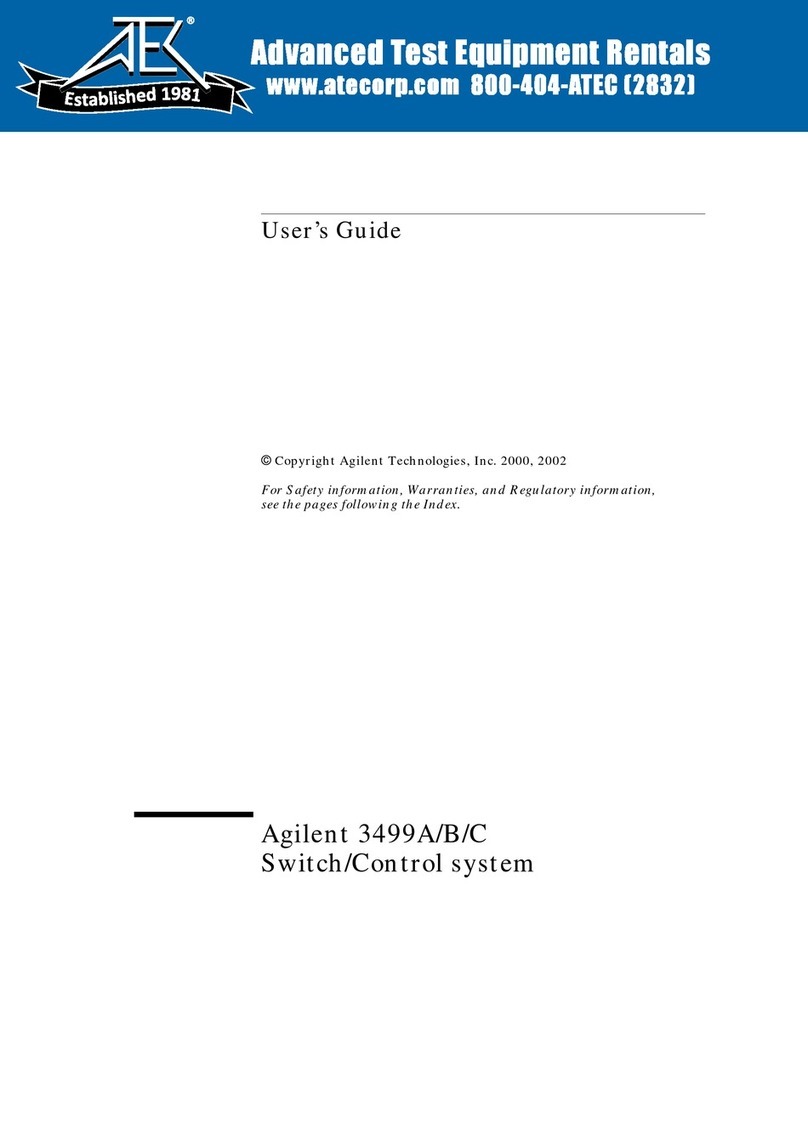
Agilent Technologies
Agilent Technologies Agilent 3499A user guide

Pentair Pool Products
Pentair Pool Products 460TC Operation and maintenance manual

Salus
Salus RT510SR installation guide
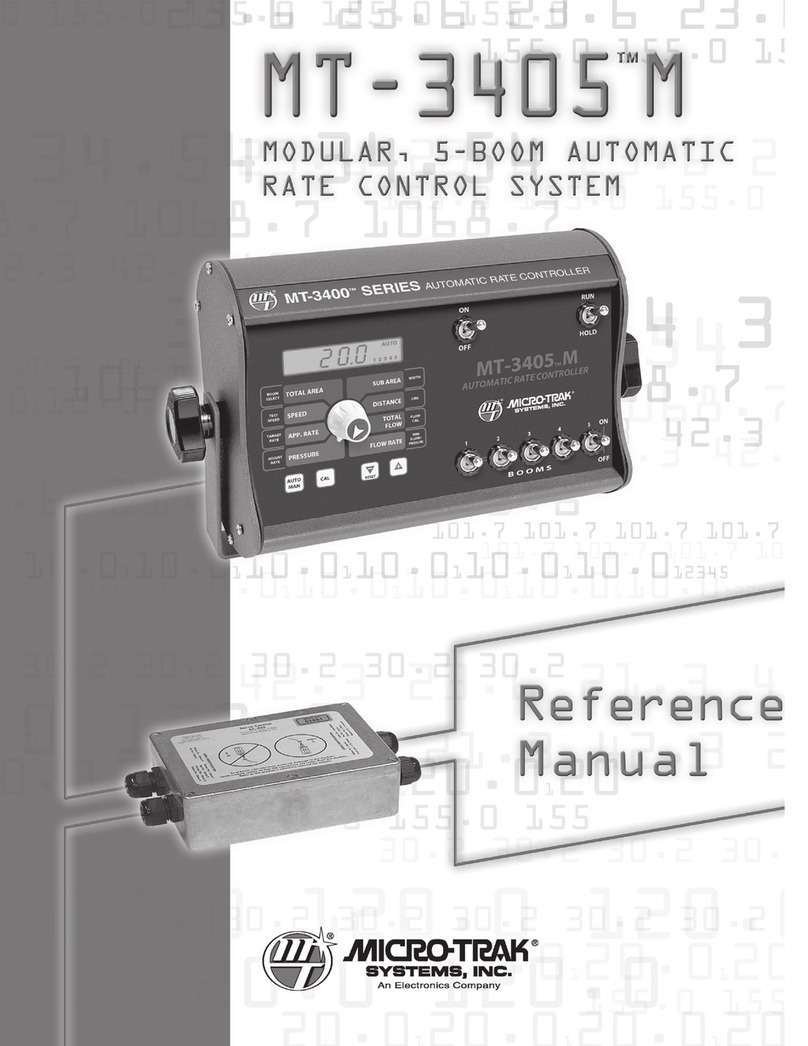
micro-trak
micro-trak MT-3405 M Reference manual
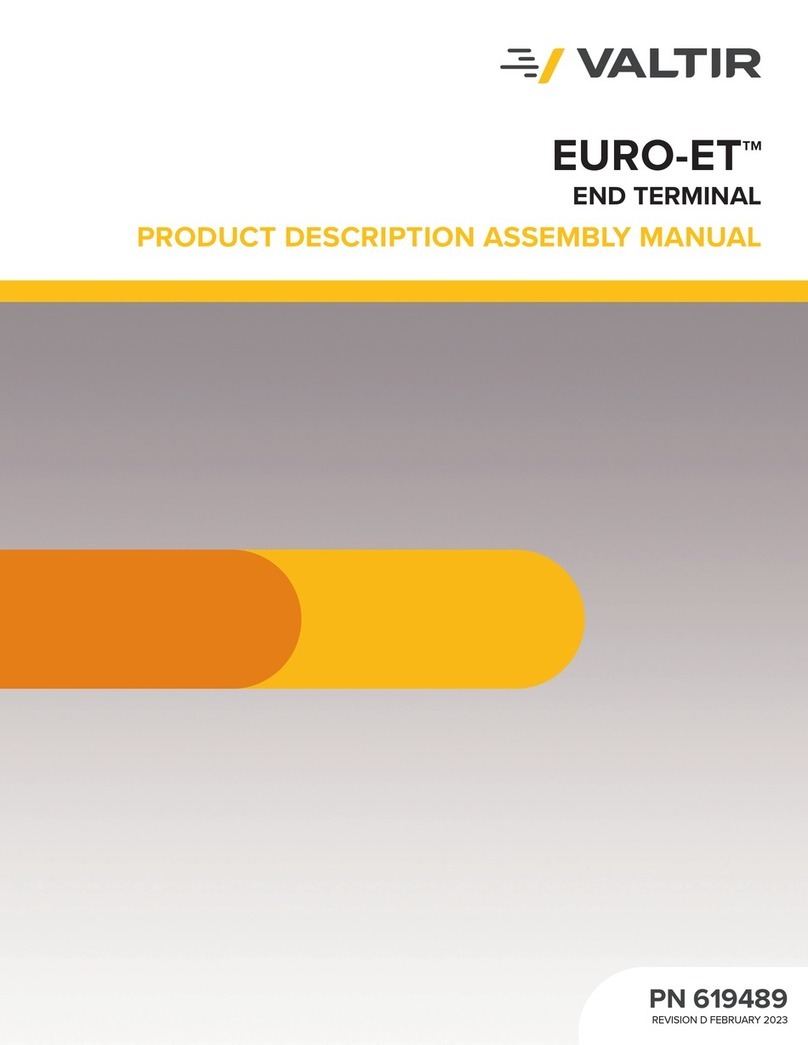
VALTIR
VALTIR EURO-ET END TERMINAL Product Description Assembly Manual
